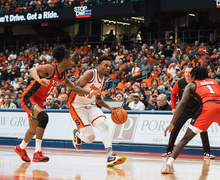Back-seat running game falters
When Syracuse football head coach Greg Robinson hired Brian Pariani to install a West Coast Offense, the spotlight shifted to the passing game. Through seven games, it hasn’t left, and rightfully so. The failures of quarterbacks Perry Patterson and Joe Fields to effectively move the ball through the air have been well documented.
But there is less talk about the running game, which is more important in Pariani’s version of the West Coast Offense than most other versions. And fact of the matter is, the running game has struggled much of the year as well. The one sure piece of the puzzle coming into the season wasn’t the quarterbacks but senior running back Damien Rhodes. He has yet to find his groove.
Rhodes and Syracuse will try to finally open some running lanes against a weak Cincinnati defense when the Bearcats visit the Carrier Dome at noon on Saturday.
While the changes to a short and intermediate passes were clear, the switch to a zone blocking system for the running game was less noticeable. Pariani said before the season and repeated last week that it takes many repetitions to become comfortable in the system. But offensive guard Steve Franklin said the new playbook had nothing to do with the team’s inconsistency.
‘Plays are plays, systems are systems – it all comes down to mental assignments,’ Franklin said. ‘You know what you got to do – it’s whether you can get it done.’
SU (1-6, 0-4 Big East) hasn’t gotten it done. Other than a 348-yard rushing performance in its only win against Buffalo on Sept. 10, SU averages a meager 78.2 yards on the ground. Likewise, Rhodes may have nearly broken the single-game SU record with 236 yards against the Bulls, but he has been stymied ever since. Rhodes has 633 yards this season. Last year, both Rhodes and Walter Reyes topped 800 yards.
Part of the problem is the non-threatening passing game. Teams have continually stacked eight or nine men near the line of scrimmage against SU this season, confident Patterson or Fields can’t beat them. Pariani wouldn’t use that as an excuse, though.
‘You can still run the ball,’ Pariani said. ‘There are still schemes you can use to get past that. Yeah, that makes it tough to run the ball, but you have to be able to do it anyway.’
Robinson noted improvement in Rhodes’ game last week against Pittsburgh. Not only did he like Rhodes’ concentration on ball control – he didn’t fumble after coughing the ball up four times against Rutgers on Oct. 15, losing two – but he also liked his more confident running style.
‘I liked the way he aggressively attacked the tackler last week,’ Robinson said. ‘He came back and responded well after the lack of ball security against Rutgers.’
Rhodes was not available to the media this week because he had a midterm.
Pariani would not say the Bearcats presented a better opportunity to run the ball, but the numbers suggest Cincinnati is soft upfront. Other than Buffalo, Cincinnati has the worst running defense of any team SU will face this season. The Bearcats yield 158.3 yards a game on the ground, 82nd in the nation. Pariani did say he wanted to see the running game hit its stride.
‘Every week you hope that’s what you want to see,’ Pariani said, ‘but it doesn’t necessarily present itself for better or worse because you are playing Cincinnati. Every game you go into, you want to run the ball. It’s always a goal.’
But the running game doesn’t happen in a vacuum. Franklin said the success of the passing game plays a large role. And until Patterson and Fields improve throwing the ball, Rhodes will continue to see entire defenses focused on him.
‘The running game hasn’t been consistent,’ Franklin said. ‘We may have a big play here or there, but it’s never consistent. That’s the problem this year. We’ve got to be consistent in what we do.’
Published on October 26, 2005 at 12:00 pm





